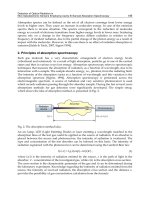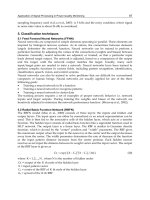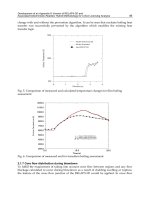Volume 09 - Metallography and Microstructures Part 5 pot
Bạn đang xem bản rút gọn của tài liệu. Xem và tải ngay bản đầy đủ của tài liệu tại đây (5.88 MB, 100 trang )
Fig. 22 ASTM A335, Grade P5, seamless steel pipe, 4.75-in. OD by
5
8
-
in. wall. Annealed by austenitizing at
900 °C (1650 °F) for 1 h and furnace cooling. Specimen was taken at midwall thickness. Alloy carbide in a
ferrite matrix. Nital. 500×
Fig. 23 ASTM A335, Grade P7, seamless steel pipe, 5.563-in. OD by 0.375-
in. wall, fully annealed. Specimen
was taken in longitudinal direction. S
tructure is fine ferrite grains (white) with a dispersion of alloy particles.
Vilella's reagent. 100×
Fig. 24 ASTM A335, Grade P11, seamless steel pipe, 5.563-in. OD by 0.375-
in. wall, fully annealed. Specimen
was taken in longitudinal direction. Light areas are ferrite; dark areas are pearlite containing some
Widmanstätten plates of ferrite. Nital. 500×
Fig. 25 ASTM A335, Grade P22, seamless steel pipe, 1.312-in. OD by 0.25-
in. wall, hot drawn and annealed by
austenitizing at 900 °C (1650 °F) for 1 h
and furnace cooling. Structure consists of a fine dispersion of alloy
carbide particles in a matrix of ferrite. Nital. 550×
Fig. 26 ASTM A381, Class Y52, gas metal arc welded steel pipe, 36-in. OD by 0.406-
in. wall, fully annealed.
Light areas in the structure are ferrite; dark areas are pearlite; some nonmetallic stringers are present in the
ferrite (toward the top of the micrograph). 2% Nital. 100×
Fig. 27 ASTM A161 seamless steel tube, 5-in. OD by
7
16
-in. wall, as hot draw
n. Specimen from midthickness
of wall in longitudinal section. Structure is ferrite and pearlite (dark). Nital. 110×
Fig. 28
ASTM A200, Grade T5, seamless alloy steel tube, annealed. Longitudinal section. Structure is a fine
dispersion of alloy carbide in a matrix of ferrite (light background). Vilella's reagent. 100×
Fig. 29 Same specimen as shown in Fig. 28, but a
t a higher magnification. Light areas are ferrite; black
particles are alloy carbide, located mostly within the ferrite grains. Vilella's reagent. 500×
Fig. 30 Same specimen as shown in Fig. 28 and 29
, but at a still higher magnification. Black constituents are
alloy carbide; matrix is ferrite. Vilella's reagent. 1000×
Fig. 31 ASTM A209, Grade T1, seamless alloy steel tube, hot finished and annealed.
Ferrite (light) and pearlite;
some banding. Nital. 100×
Fig. 32 Same steel as Fig. 31
, but cold drawn and stress relieved. Micrograph from longitudinal section. Ferrite
and pearlite (see also Fig. 33). Nital. 100×
Fig. 33 Same specimen as shown in Fig. 32
, but at a higher magnification. The light areas in the structure are
ferrite, and the dark areas are pearlite. Nital. 500×
Fig. 34 ASTM A213, Grade T5c, steel tube, hot finished to a 2-in. OD by 0.22-
in. wall, held at 730 °C (1350 °F)
and air cooled. Dispersed chromium and titanium carbides in ferrite. Vilella's reagent. 100×
Fig. 35 Same specimen as shown in Fig. 34
, but at a higher magnification. The carbide particles are more
completely resolved. The small dark areas are titanium carbide. Vilella's reagent. 500×
Fig. 36 Copper brazed joints (outlined white bands) in spiral-
wound tubing made from ASTM A254, Class I,
steel. Specimen is a cross section. Structure is mostly ferrite. 2% Nital. 100×
Fig. 37 1015 steel tube, resistance welded without filler metal. Vertical band through
the center is the fusion
zone; heat-affected zones are on each side. Transverse section. Nital. 100×
Fig. 38 Same as Fig. 37
, except that the tube has been normalized. Light areas are ferrite; dark areas,
pearlite. Weld zone is at center. Note general uniformity of structure. Nital. 100×
Fig. 39 Same as Fig. 38
, except the tube has been cold drawn (note elongated grains). A longitudinal section
that was taken near the weld zone. The structure of the weld is the same as the base steel. Nital. 100×
Fig. 40 Same as Fig. 39
, but specimen is transverse to the direction of the weld. The tube has been normalized
and cold drawn after welding. Structure is ferrite (light constituent) and pearlite (dark constituent). Nital. 100×
Fig. 41 Same as Fig. 40
, except the tube has now been renormalized after cold drawing. Structure is equiaxed
ferrite and pearlite. Renormalizing apparently caused some coarsening of the grains (compare with Fig. 38
).
Nital. 100×
Fig. 42 Same as Fig. 39, except after normalizing, cold drawing, and renormalizing.
Specimen is longitudinal.
Note equiaxed ferrite grains. Nital. 100×
Fig. 43 1018 steel tubing, showing a transverse section near the longitudinal seam after we
lding and
normalizing. Note flow pattern. Nital. 100×
Fig. 44 Aluminate inclusion (longitudinal) in 1025 cold drawn steel tube. As-polished. 500×
Fig. 45 Segmented sulfide inclusion (longitudinal) in 1215 cold drawn steel tube. As-polished. 1000×
Fig. 46
4140 steel tube, annealed by austenitizing at 845 °C (1550 °F), for 3 h, furnace cooling to 620 °C
(1150 °F), and air cooling to room temperature. Structure is ferrite and pearlite. Nital. 1000×
Fig. 47 4140 steel tube, austenitized at 830 °C (1
525 °F) for 1 h, oil quenched, tempered at 595 °C (1100 °F)
for 2 h. The structure consists of some ferrite (white) in tempered martensite. Nital. 1000×
Fig. 48 Silicate (black) and sulfide (gray) inclusions in 4620 steel tube. As-polished. 500×
Fig. 49 Decarburization at the surface of 5048 steel seamless tube (transverse). Nital. 100×
Fig. 50 Large silicate inclusion (longitudinal) in 8620 steel tube. As-polished. 250×
Carbon and Low-Alloy Steel Castings: Metallographic Techniques and Microstructures
Introduction
CARBON AND LOW-ALLOY STEEL CASTING specimens are prepared using the techniques described in the article
"Carbon and Alloy Steels" in this Volume.
Sectioning. As-cast and heat-treated steel castings are usually soft enough to permit sawing or hollow boring for initial
extraction of test pieces. The oversize pieces are then sawed or abrasive-wheel cut to specimen size. If the casting is hard,
abrasive-wheel cutting is used. Precautions must be taken against overheating during cutting. Even with the application of
copious water, it is possible to overheat the piece being sectioned.
Section thickness in a single steel casting can vary from a fraction of an inch to many inches, resulting in different
cooling rates and thus in different microstructures within ascast and heat-treated castings. Therefore, for complete
examination of a casting, several specimens may have to be extracted. Some of the micrographs in this article compare
the structures observed in sections of different thicknesses (see Fig. 4, 5, and 6 in the section "Atlas of Microstructures for
Carbon and Low-Alloy Steel Castings" in this article).
Mounting. Bakelite is often used for mounting specimens. The microstructures of most steel castings are not affected by
the thermosetting temperature of Bakelite. In some foundry laboratories, cold-mounting materials (described in the article
"Mounting of Specimens" in this Volume) are used more often than Bakelite.
Grinding and polishing techniques described for specimens of wrought steels apply to specimens from steel castings.
Steel castings frequently are examined for the presence and identification of inclusions, and methods of inclusion
preservation are essential. Grinding usually includes use of a belt or disk grinder and 180-, 240-, 400-, then 600-grit
silicon carbide abrasive paper.
The specimen is then rough polished on a nylon or canvas polishing cloth charged with 3- to 9-μm diamond paste. Final
polishing is performed using a low-napped rayon cloth charged with a slurry of water containing 0.05-μm alumina
(Al
2
O
3
). Excessive polishing must be avoided to prevent extraction of inclusions. Examination for inclusions is performed
before etching.
Etching. Nital is the etchant most often used for specimens from steel castings. Picral is sometimes used, especially for
castings with carbon contents of more than 0.30%. Carbide structures usually are resolved better with picral than with
nital. Electrolytic etching is only rarely employed for specimens from carbon or low-alloy steel castings.
Microstructures of Carbon and Low-Alloy Steel Castings
The microstructures presented in this article are those of carbon and low-alloy steel castings in the as-cast, annealed,
normalized, normalized and tempered, and quenched and tempered conditions in 25-mm (1-m.), 75-mm (3-in.), and 150-
mm (6-in.) thick sections. Stainless steel castings, austenitic manganese steels, and heat-resistant alloy castings are
covered in separate articles in this Volume.
Steel castings are classified in accordance with the standards provided in Volumes 01.01 and 01.02 of the Annual Book of
ASTM Standards. The composition limits of steels illustrated in this article are listed in Table 1. The structures of castings
meeting the same ASTM standard often differ widely because of the permissible limits in composition, differences in
section thickness, and variations in foundry and heat treating practice from plant to plant. Properties and selection of steel
castings are discussed in the article "Steel Castings" in Properties and Selection: Irons, Steels, and High-Performance
Alloys, Volume 1 of ASM Handbook, formerly 10th Edition Metals Handbook.
Table 1 Compositions of carbon and low-alloy steel castings
(a)
Composition, % Steel
C Mn Si P S Other
A27, grade 70-36 0.35 max
0.70 max
0.80 max
0.05 max
0.06 max . . .
Al 28, grade B-3 1.12-1.28
11.5-14.0
1.00 max
0.07 max
. . . . . .
A148 Specification sets mechanical-property limits
A216, grade WCA
0.25 max
0.70 max
0.60 max
0.04 max
0.045 max
(b)
A216, grade WCB
0.30 max
1.00 max
0.60 max
0.04 max
0.045 max
(b)
A352, grade LC3 0.15 max
0.50-0.80
0.60 max
0.04 max
0.045 max
3-4 Ni
(a)
Where not specified by ASTM number, composition is given in the micrograph figure caption.
(b)
Residual elements, 1% max total, including O.50% max Cu, 0.50% max Ni,0.40%, max Cr, 0.25% max Mo, 0.03% max V.
(c)
Also contains 0.10 to 0.30% Mo. Residual elements, 1% max total, including 0.50% max Cu, 0.50% max Ni, 0.35% max Cr, 0.10%, W
Carbon Steel Castings. The microstructures of carbon steel castings shown in this article are for castings conforming
to ASTM Standards A 27 (Ref 1), A 148 (Ref 2), and A 216 (Ref 3). Most of the steels have a carbon content of more
than 0.25%, and some contain 0.45% C.
ASTM A 27 covers low to mediums-strength carbon steel castings for general applications. The grades are not severely
restricted as to composition. Maximum carbon ranges from 0.25 to 0.35% and maximum manganese from 0.60 to 1.20%,
depending on the grade. Strength specifications range from no specific requirements to those for grade 70-40, which must
exhibit minimum tensile strength of 485 MPa (70 ksi) with minimum yield strength of 275 MPa (40 ksi). Figures 1, 2, 3,
4, 5, 6, 7, 8, 9, 10, 11, 12, 13, and 14 in the section "Atlas of Microstructures for Carbon and Low-Alloy Steel Castings"
in this article show microstructures of ASTM A27 grade 70-36 steel.
Higher strength carbon steel castings are covered by ASTM A 148, in which maximums on sulfur and phosphorus are the
only composition restrictions. Minimum tensile strength requirements vary from 550 to 1795 MPa (80 to 260 ksi) and
minimum yield strengths from 275 to 1450 MPa (40 to 210 ksi) for the 14 grades in A 148. Figures 15, 16, 17, 18, 19, 20,
and 21 illustrate microstructures of steel covered by this standard.
Carbon steel castings suitable for fusion welding for high-temperature service are represented in ASTM A 216.
Micrographs in this article are for two grades: WCA (Fig. 22, 23, 24, 25, 26, 27, and 28 ) and WCB (Fig. 29, 30, 31, 32,
33, 34, 35). A third grade, WCC, is not shown. All grades are categorized as carbon steels, because alloying or residual
elements are not specified; maximum limits on copper, nickel, chromium, molybdenum, and vanadium vary from 0.03%
V to 0.50% Ni and Cr. The maximum total of all residual elements is set at 1.00%.
Heat treatment and section thickness influence the microstructure of cast steel. Therefore, the micrographs in this article
show each steel in various conditions. Slower cooling rates of thicker sections usually result in different constituents and
in coarsening of the structure.
Two micrographs (Fig. 36 and 37) of a medium-carbon steel in the normalized condition show the effect of increasing
magnification on the resolution of the microconstituents.
Low-Alloy Steel Castings. The micro-structures of low-alloy steel castings shown in this article are for castings
conforming to ASTM Standards A487 (Ref 4) and A352 (Ref 5). ASTM A487 steel castings are intended for pressure
service and must be heat treated by normalizing, normalizing and tempering, or by quenching and tempering. The
castings must also be weldable. Figures 38, 39, and 40 in the section "Atlas of Microstructures for Carbon and Low-Alloy
Steel Castings" in this article are micrographs of normalized ASTM A487 steel castings.
ASTM A352 steel castings are intended for pressure-containing parts suitable for service to -115 °C (-175 °F). Ferritic
castings are normalized and tempered or liquid-quenched and tempered (Fig. 41) before being placed in service. The one
martensitic grade, CA6NM, in ASTM A352 should be heated to 955 °C (1750 °F) minimum and air cooled to 95 °C (200
°F) maximum prior to any optional intermediate temper. This grade, however, should be cooled to 40 °C (100 °F)
maximum before the final temper, which is between 565 and 620 °C (1050 and 1150 °F).
References cited in this section
1.
"Standard Specification for Steel Castings, Carbon, for General Application," A 27,
Annual Book of ASTM
Standards, Vol 01.02, ASTM, Philadelphia, 1984
2.
"Standard Specification for Steel Castings, High Strength, for Structural Purposes," A 148,
Annual Book of
ASTM Standards, Vol 01.02, ASTM, Philadelphia, 1984
3.
"Standard Specif
ication for Steel Castings, Carbon, Suitable for Fusion Welding, for High Temperature
Service," A 216, Annual Book of ASTM Standards, Vol 01.02, ASTM, Philadelphia, 1984
4.
"Standard Specification for Steel Castings, Suitable for Pressure Service," A 487,
Annual Book of ASTM
Standards, Vol 01.02, ASTM, Philadelphia, 1984
5.
"Standard Specification for Steel Castings, Ferritic and Martensitic, for Pressure Containing Parts, Suitable
for Low Temperature Service," A 352, Annual Book of ASTM Standards, Vol 01
.02, ASTM, Philadelphia,
1984
Atlas of Microstructures for Carbon and Low-Alloy Steel Castings
Fig. 1 ASTM A27 steel (0.25% C), 25 mm (1 in.) thick, in as-
cast condition. Structure is proeutectoid ferrite
(white) at prior austenite grain boundaries, and a mixture of ferrite and pearlite within grains. Nital. 100×
Fig. 2 Some steel as for Fig. 1, 25 mm (1 in.) thick,
annealed by austenitizing at 925 °C (1700 °F) for 1 h at
temperature and furnace cooling. Ferrite (white) and pearlite (dark) outline the original dendritic structure.
Nital. 100×
Fig. 3 Same steel as for Fig. 1, 150 mm (6 in.) thick. Heat treatment was the same as for Fig. 2. Structure is
essentially the same as for Fig. 2, but grains are coarser because of the greater thickness of the section. Nital.
100×
Fig. 4 Same steel as for Fig. 1, 25 mm (1 in.) thick,
quenched and tempered. Austenitized at 925 °C (1700 °F)
for 1 h at temperature, quenched in mildly agitated water, tempered at 675 °C (1250 °F) for 2 h. Note fine-
grained microstructure of ferrite (white) and pearlite. Nital. 200×
Fig. 5 Some steel as for Fig. 1
, 75 mm (3 in.) thick. Quenching and tempering treatment was the same as for
Fig. 4. The microstructure is nearly the same as for Fig. 4, but slightly coarser. See Fig. 6
for the structure of a
thicker section after the same heat treatment. Nital. 200×
Fig. 6 Same steel as for Fig. 1, 150 mm (6 in.) thick. Quenching and
tempering treatment was the same as for
Fig. 4. The microstructure consists of the same constituents as Fig. 4 and 5
, but grains are significantly coarser
because of the greater thickness of the section. Nital. 200×
Fig. 7 ASTM A27 steel, grade 70-36 (0.26% C, 0.71 % Mn), 25-mm (1-
in.) cube, normalized by austenitizing
at 1205 °C (2200 °F) for 30 min and air cooling. Widmanstätten pattern of proeutectoid ferrite in a matrix of
ferrite and pearlite. 4% Nital. 250×
Fig. 8 ASTM A27 steel, grade 70-
36 (0.30 to 0.40% C), 25 mm (1 in.) thick, as cast. Ferrite (white) and
pearlite (dark). Higher carbon content than that of steel in Fig. 1
results in a greater proportion of pearlite.
Nital. 250×
Fig. 9 Same steel as for Fig. 8
, 25 mm (1 in.) thick, but after being normalized by austenitizing at 900 °C
(1650 °F) for 1 h and air cooling. Structure consists of ferrite (white constituent) and pearlite (dark
constituent). Nital. 250×
Fig. 10 Same steel as for Fig. 8
, 25 mm (1 in.) thick, quenched and tempered. Austenitized at 900 °C (1650
°F) for 1 h, water quenched, tempered at 620 °C (1150 °F) for 2 h. Structure is tempered martensite and
ferrite (white). Nital. 250×
Fig. 11 Same steel as for Fig. 8
, 75 mm (3 in.) thick, but after being normalized by austenitizing at 900 °C
(1650 °F) for 3 h and air cooling. The structure consists of pearlite (dark constituent) and ferrite (light
constituent). Nital. 250×
Fig. 12 Same steel as for Fig. 8
, 75 mm (3 in.) thick, quenched and tempered. Austenitized at 900 °C (1650
°F) for 3 h, water quenched, tempered at 620 °C (1150 °F) for 4 h. Structure: tempered martensite, pearlite,
and ferrite. Nital. 250×
Fig. 13 Same steel as for Fig. 8
, 150 mm (6 in.) thick, normalized by austenitizing at 900 °C (1650 °F) for 6 h
and air cooling. The microstructure consists of lamellar pearlite (gray and black) and ferrite (white). Nital. 250×
Fig. 14 Same steel as for Fig. 8, 150
mm (6 in.) thick, quenched and tempered. Austenitized at 900 °C (1650
°F) for 6 h, water quenched, tempered at 620 °C (1150 °F) for 6 h. Structure is fine pearlite and ferrite (white).
Nital. 250×
Fig. 15 ASTM A148 steel, grade 90-
60 (0.30% C, 1.65% Mn), 25 by 25 by 13 mm (1 by 1 by 0.5 in.), in the
as-cast condition. The microstructure consists of ferrite (white) in a matrix of pearlite (dark). 4% nital. 100×
Fig. 16 Same steel and size as for Fig. 15
, normalized by austenitizing at 900 °C (1650 °F) for 20 min and air
cooling. Structure: a fine-grained aggregate of ferrite and pearlite. 4% nital. 100×
Fig. 17 ASTM A148 steel, grade 90-
60 (0.27% C, 0.80% Mn, 0.51 % Si, 0.35% Mo), 25 mm (1 in.) thick,
normalized and tempered. Austenitized
at 925 °C (1700 °F) for 1 h, air cooled, tempered at 705 °C (1300 °F)
for 3 h. Structure is fine-grained ferrite and pearlite. 5% nital. 100×
Fig. 18 Same steel as for Fig. 17, 150 mm (6 in.) thick, normalized and tempered. Austenitized at 925
°C
(1700 °F) for 6 h, air cooled, tempered at 705 °C (1300 °F) for 4 h. Structure: fine-
grained aggregate of ferrite
and pearlite. Note dendritic segregation of carbon and manganese. 5% nital. 100×
Fig. 19
ASTM A148 steel (0.45% C), 75 mm (3 in.) thick, annealed by austenitizing at 900 °C (1650 °F) for 5 h
and furnace cooling to room temperature in 10 h. Structure consists of b
locky ferrite and ferrite at prior
austenite grain boundaries in a matrix of pearlite (dark). 5% nital. 100×
Fig. 20 Same steel as for Fig. 19
, 150 mm (6 in.) thick, quenched and tempered. Austenitized at 900 °C (1650
°F) for 3 h to temperatur
e and held 5 h, water quenched, tempered at 595 °C (1100 °F) for 4 h to temperature
and held 6 h, air cooled. Very fine ferrite and spheroidized pearlite. 5% nital. 100×
Fig. 21 ASTM A148 steel, grade 105-
85 (0.27% C, 0.80% Mn, 0.51 % Si, 0.35% Mo), 150 mm (6 in.) thick,
quenched and tempered. Austenitized at 925 °C (1700 °F) for 4 h, water quenched, tempered at 650 °C (1200
°F) for 4 h. Proeutectoid ferrite (white) in a matrix of tempered martensite. 5% nital. 500×
Fig. 22 ASTM A216 steel, grade WCA (0.21 % C, 0.60% Mn, 0.49% Si), 25 mm (1 in.) thick, as-
cast. The
microstructure consists of pearlite (dark constituent), blocky ferrite, and Widmanstätten platelets of ferrite.
2%
nital. 100×
Fig. 23 Same steel as for Fig. 22, 25 mm (1 in.) t
hick, normalized and tempered. Austenitized at 925 °C (1700
°F) for 1 h, air cooled, tempered at 705 °C (1300 °F) for 3 h. The structure consists of fine pearlite in a matrix
of ferrite (white). 2% nital. 100×
Fig. 24 Same steel as for Fig. 22
, 25 mm (1 in,) thick, annealed by austenitizing at 925 °C (1700 °F) for 1 h,
and furnace cooling. Structure consists of ferrite (light) and pearlite (dark). Pattern of pearlite reflects primary
dendritic segregation of carbon and manganese. 2% nital. 100×
Fig. 25
ASTM A216 steel, grade WCA (0.21 % C, 0.60% Mn, 0.49% Si), 75 mm (3 in.) thick, annealed by
austenitizing at 925 °C (1700 °F) for 6 h, and furnace cooling. Same structure as Fig. 24
, but "cell" size of
carbon and manganese segregation is larger, because the section is thicker. 2% nital. 100×
Fig. 26 Same steel as for Fig. 25
, 75 mm (3 in.) thick, quenched and tempered. Austenitized at 925 °C (1700
°F) for 3 h, water quenched, tempered at 650 °C (1200 °F) for 4 h. Structure
consists of fine pearlite and
probably some upper bainite (dark) in a matrix of ferrite (white). 2% nital. 100×
Fig. 27 Same steel as for Fig. 25
, 150 mm (6 in.) thick, normalized and tempered. Austenitized at 925 °C
(1700 °F) for 6 h, air co
oled, tempered at 705 °C (1300 °F) for 4 h. Structure consists of fine pearlite in a
matrix of blocky ferrite (light) with platelets of Widmanstätten ferrite. 2% nital. 100×
Fig. 28 Same steel as for Fig. 25, 150 mm (6 in.) thick, quenched and
tempered. Austenitized at 925 °C (1700
°F) for 6 h, water quenched, tempered at 650 °C (1200 °F) for 4 h. Structure is fine-
grained ferrite with some
platelets of Widmanstätten ferrite and fine pearlite (dark). 2% nital. 100×
Fig. 29
ASTM A216, grade WCB (0.27% C), 25 mm (1 in.) thick, annealed by austenitizing at 870 °C (1600 °F)
for 8 h and furnace cooling. Structure consists of blocky pearlite (dark) and blocky ferrite (white).
2% nital.
500×
Fig. 30 Same steel as for Fig. 29
, 75 mm (3 in.) thick, normalized by austenitizing at 925 °C (1700 °F) and air
cooling. Structure consists of fine pearlite in a matrix of ferrite (light). 3% nital. 75×
Fig. 31 Same steel and heat treatment as for Fig. 30
, but at a higher magnification. White grains (note distinct
boundaries) are blocky ferrite; dark areas are fine, lamellar pearlite. 2% nital. 500×
Fig. 32 Same steel as for Fig. 29, 75 mm (3 in.) thick, as-
quenched condition. Austenitized at 925 °C (1700
°F) and quenched in oil. The structure consists of fine pearlite in a matrix of ferrite. 3% nital. 75×
Fig. 33 ASTM A216, grade WCB (0.27% C) 75 mm (3 in.) thick, heat treated as for Fig. 32
, but shown at
higher magnification. Fine pearlite in a ferrite matrix. Note MnS inclusions (globular). 2% nital. 500×
Fig. 34 Same steel as for Fig. 33, 150 mm (6 in.) thick, normalized b
y austenitizing at 925 °C (1700 °F) and
air cooling. Structure: fine and coarse pearlite in a coarse-grained ferrite matrix. 2% nital. 500×
Fig. 35 Same steel as for Fig. 33, 150 mm (6 in.) thick, in the as-quenched condition. Austenitized at
925 °C
(1700 °F) and oil quenched. Pearlite (dark), randomly dispersed in ferrite (white).
Note the gray MnS inclusion
at the left. 2% nital. 500×
Fig. 36
Cast steel with 0.45% C, 0.70% Mn, 0.40% Si, normalized by austenitizing at 955 °C (1750 °F) for 30
min and cooling in air. Structure is a mixture of ferrite (white) and pearlite (dark), which is not well resolved.
4% nital. 100×
Fig. 37 Same area as for Fig. 36
, but at a still higher magnification. Parallel plate structure of the pearlite is
now well resolved. A magnification of 500× (as here) is often best for this structure and grain size. 4% nital.
Fig. 38
ASTM A487 steel, class 2, 25 mm (1 in.) thick, normalized by austenitizing at 900 °C (1650 °F) and air
cooling. The structure consists of pearlite and ferrite. See Fig. 39 and 40
for influence of alternate heat
treatment and section size. 4% nital. 250×
Fig. 39
ASTM A487 steel, 25 mm (1 in.) thick, normalized by austenitizing at 955 °C (1750 °F) for 3 h, held 5
h, air cooled, tempered at 660 °C (1225 °F) for 4 h to temperature, and held 6 h. The lighter areas are fine
ferrite; the darker areas are probably bainite delineating prior austenite grain boundaries. 5% nital. 1000×









